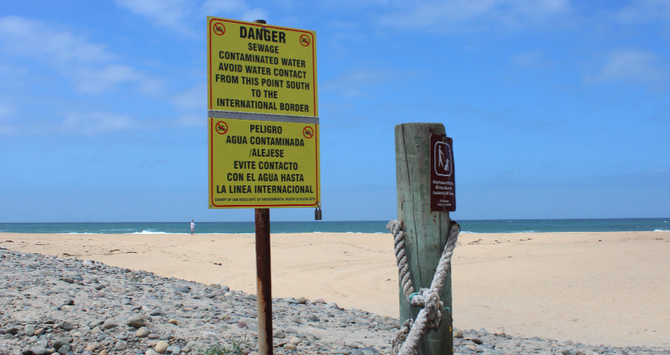 Facebook
Facebook
 X
X
 Instagram
Instagram
 TikTok
TikTok
 Youtube
Youtube

On Thursday, May 23, Heal the Bay representatives met at the mouth of the Tijuana River to announce their annual “beach report card.”
While the organization gave the majority of San Diego County high grades for beach quality, during wet weather the Tijuana River mouth was given a grade of “F.”
Taking its information from five agencies within San Diego County, including the San Diego County Department of Environmental Health, Heal the Bay found that beach water quality during 2012–2013 was excellent in San Diego County. The strip of beach at the mouth of the Tijuana River, however, earned C grades and below.
The polluted area, located in Imperial Beach, only re-opened on Wednesday, May 22, although the warning sign still hadn’t come down. The department of environmental health closed the beach last December.
James Alamillo from Heal the Bay explained, “San Diego beaches are doing very well. We haven’t had much rain, and no rain means no flow of pollutants going from rivers, creeks, and storm drains into the ocean.”
Alamillo wasn’t completely pessimistic about the beaches near the Tijuana River. He said, “It’s a great place to come during the summer months when it’s not raining. It’s also a great place to come during the winter months when it’s not raining. You still have A-level quality water here. But the study shows that whenever it did rain, all the beaches south of the Imperial Beach Pier could not break a C-level grade. You saw C’s, D’s and F’s between the pier and Border Field State Park.”
WildCoast representative Paloma Aguirre, provided a local perspective, explaining that chronic water-quality issues in south San Diego are a result of pollution stemming from the Tijuana River and also due to an aging infrastructure in the city of Tijuana that causes sewage spills.
“We’re constantly working to increase binational collaboration between Mexico and the U.S. because we share a watershed between both nations,” said Aguirre. “The issues do come from Tijuana when it comes to water quality, and it impacts all of the beaches in south San Diego up to Coronado.”
The mouth of the Tijuana River is the last undeveloped coastal wetland in Southern California. An estuary’s natural job is to filter out pollutants, but during wet weather the contaminants flowing through the Tijuana River are far too overwhelming for this natural process to take place. During Heal the Bay’s reporting period, San Diego’s four southernmost beaches were closed for 139 days.


On Thursday, May 23, Heal the Bay representatives met at the mouth of the Tijuana River to announce their annual “beach report card.”
While the organization gave the majority of San Diego County high grades for beach quality, during wet weather the Tijuana River mouth was given a grade of “F.”
Taking its information from five agencies within San Diego County, including the San Diego County Department of Environmental Health, Heal the Bay found that beach water quality during 2012–2013 was excellent in San Diego County. The strip of beach at the mouth of the Tijuana River, however, earned C grades and below.
The polluted area, located in Imperial Beach, only re-opened on Wednesday, May 22, although the warning sign still hadn’t come down. The department of environmental health closed the beach last December.
James Alamillo from Heal the Bay explained, “San Diego beaches are doing very well. We haven’t had much rain, and no rain means no flow of pollutants going from rivers, creeks, and storm drains into the ocean.”
Alamillo wasn’t completely pessimistic about the beaches near the Tijuana River. He said, “It’s a great place to come during the summer months when it’s not raining. It’s also a great place to come during the winter months when it’s not raining. You still have A-level quality water here. But the study shows that whenever it did rain, all the beaches south of the Imperial Beach Pier could not break a C-level grade. You saw C’s, D’s and F’s between the pier and Border Field State Park.”
WildCoast representative Paloma Aguirre, provided a local perspective, explaining that chronic water-quality issues in south San Diego are a result of pollution stemming from the Tijuana River and also due to an aging infrastructure in the city of Tijuana that causes sewage spills.
“We’re constantly working to increase binational collaboration between Mexico and the U.S. because we share a watershed between both nations,” said Aguirre. “The issues do come from Tijuana when it comes to water quality, and it impacts all of the beaches in south San Diego up to Coronado.”
The mouth of the Tijuana River is the last undeveloped coastal wetland in Southern California. An estuary’s natural job is to filter out pollutants, but during wet weather the contaminants flowing through the Tijuana River are far too overwhelming for this natural process to take place. During Heal the Bay’s reporting period, San Diego’s four southernmost beaches were closed for 139 days.
Comments